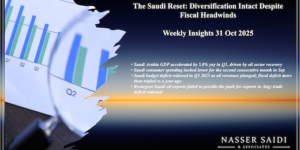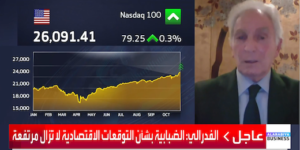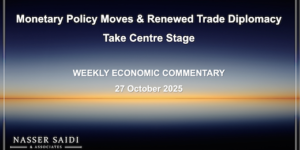Markets
The recent partial recovery in the FTSE All-World index and the S&P 500 led to a broadly upbeat mood across markets (as US-China trade talks struck a positive tone and in spite of the ongoing US government shutdown), especially ahead of the US quarterly earnings season next week. In Europe, the Stoxx closed higher though other markets ended negative on weak data (also affected the euro) and lack of clarity on the trade talks. Regional equity markets were mostly up, with Qatar’s index hitting the highest since Mar 2017. On the currency front, onshore Renminbi posted the best week versus the dollar since 2005 while the pound sprang to a 2-week peak vis-à-vis the euro on optimism on a possible Brexit extension. Oil prices saw a temporary reprieve with Brent oil price holding above USD 60 per barrel and gold price edged up posting a fourth straight week of gains.
Global Developments
US/Americas:
- US ISM non-manufacturing PMI dipped to 57.6 in Dec (Nov: 60.7), expanding at the slowest pace since Jul. Prices fell 6.7 ppts to 57.6 while employment slipped 2.1 ppts to 56.3.
- Jobless claims fell to a one-month low of 216k, declining by 17k last week. The four-week average of initial claims rose 2500 to 221,750 last week.
- US inflation dropped by 0.1% mom in Dec, the first drop and weakest reading since Mar, thanks to a plunge in gasoline prices (-7.5%). The core CPI, excluding food and energy, rose 2.2% yoy, unchanged from the previous month.
Europe:
- Retail sales increased 0.6% mom and by 1.1%yoy in the Euroarea in Nov.
- Industrial production in Germany declined by 1.9% mom and 4.7% yoy in Nov; the yoy decline was the worst since 2009.
- German factory orders slumped by 1% mom and 4.3% yoy in Nov (Oct: 0.2% mom), as the 2.4% pickup in domestic orders could not offset the 3.2% decline in orders from abroad.
- TheEuropean Commission’s economic sentiment indicator fell to a 23-month low of 107.3 in Dec in the Euroarea, down from 109.5 in Nov. Economic morale fell in the five largest euro-area countries, led by Spain (−3.0), France (−2.0), Germany (−1.9) and Italy (−1.4) and the Netherlands (−0.3).
- Eurozone unemployment rate remained stable at a decade-low of 7.9% in Nov; youth unemployment in Italy, Spain and Greece still remains above 30%.
- UK Halifax house prices reported a surprise increase in Dec– rising 2.2% mom (Nov: -1.2%) – the fastest rate in almost two years.
Asia Pacific:
- China’s forex reserves fell in 2018, declining by USD 67.24bn to USD 3.073trn. The value of China’s gold reserves rose to USD 76.331bn from USD 72.122bn at end-Nov.
- A slew of data was released from China last week: inflation fell to a six-month low of 1.9% yoy in Dec (Nov: 2.2%)– well below the 3% upper limit set by the PBoC – while factory prices dived to a 2-year low of 0.9% in Dec (Nov: 2.7%). FDI into China rose by 3% yoy to USD 135bn in 2018, a marked decline from7.9% recorded in 2017.
- Chinese commercial banks’ non-performing loan(NPL) ratio hit a 10-year high of 1.89%, rising to CNY 2trn (USD 296.52bn) at the end of last year.
- Singapore retail sales declined by 3% yoy in Nov, due to a drop in car sales (-15.1% yoy) and sales of computer and telecommunications equipment (-22.1%). Excluding motor vehicles, retail sales decline only 0.2%.
- Japan’s leading economic index fell to a two-year low of 99.3 in Nov (Oct: 99.6). The coincident index dropped to 103 from 104.9 the month before; the assessment of the coincident index was “weakening”.
- Unemployment rate in Korea touched a 17-year high of 3.8% in 2018. The number of employed people in Korea rose by only 97k in 2018, the lowest increase since 2009, when 87k jobs were lost.
- Japan’s current account surplus narrowed by 43% yoy to JPY 757.2bn (USD 7bn) in Nov – falling below the JPY 1trn mark for the first time in 10 months – on higher oil imports.Trade balance posted a deficit (for the second consecutive month)of JPY 559.1bn as imports grew by 13.5% and imports by 1.9%.
- India approved a proposal for a USD 75bn bilateral swap arrangement with Japan, a move aimed at enhancing the RBI’s ability to manage exchange rate volatility.
Bottom line: The World Bank in its latest Global Economic Prospects predicts “darkening skies” with global growth expected to slow to 2.9% this year (amid more acute downside risks). While the China-US trade negotiations progressed, lack of tangible details associated with the talks is likely to prolong the uncertainty related to trade, growth and investment. This week will witness another crunch Brexit vote (on May’s EU withdrawal lead) that could potentially lead to an extension of Mar 29 deadline and/or move to 2ndreferendum.
Regional Developments
- Bahrain attracted BHD 314mn(USD 830mn) in investments into the economy in 2018, from 92 companies, disclosed the Bahrain Economic Development Board. In the first 9 months of 2018, the nation had attracted USD 810mn in investments, up 138% yoy.
- Egypt’s PMI shrank for the fourth consecutive month in Dec, though the index reading increased to 49.6 in Dec (Nov: 49.2). While the new orders and employment continued to fall, the increase in input prices was its slowest in almost six and a half years.
- The current account deficit in Egypt narrowed by 0.17% yoy to USD1.751bn during Jul-Sep 2018; meanwhile, trade deficit increased to USD 9.9bn from USD 8.91bn a year ago, with exports rising 16% to USD 6.79bn and imports up 13% to USD 16.68bn.
- Annual urban consumer price inflation in Egypt tumbled to 12% in Dec (Nov: 15.7%), thanks to a 6.7% mom drop in the price of food and beverages. Core inflation increased to 8.3% yoy from Nov’s 7.94%.
- Egypt’s foreign currency reserves fell to USD 42.551bn in Dec (Nov: USD 44.513bn) – recording the first drop since the devaluation in 2016.
- Total amount of loans extended to SMEs under a central bank initiative reached EGP 180bn by end-2018, according to the chairman of Egypt’s Association of Investors for SMEs. He also disclosed that banks would direct EGP 50bn of funding to SMEs this year (up 66.7% yoy on the EGP 30bn given last year).
- Iraq’s oil minister reaffirmed the nation’s commitment to keep oil production stable at an average of 4.513mn barrels per day in the next 6 months, in line with the OPEC+ oil output reduction.
- The World Bank forecasts 2.3% growth in GDP this year in Jordan, with a slight increase to 2.4% and 2.7% respectively in 2020 and 2021. Separately, the World Bank also agreed to offer USD 1.2bn loan to help reschedule its debts and improve investment in the public and private sectors.
- Jordan decreased the general sales tax on 61 essential commodities to 10% from16% previously.
- Kuwait’s current account surplus touched KWD 2.1bn (USD 6.9bn) in Q32018, according to the central bank, with the surplus narrowing by 18.6% qoq.
- Kuwait’s oil exports increased by 20.2% yoy to KWD 11.9mn (USD 39.27mn) in Dec; Arab countries accounted for 72% of the overall Kuwaiti exports (KWD 9.3mn).
- According to Lebanon’s Finance Minister, the ministry is preparing a “financial correction plan” to manage its public debt including the option of “restructuring of public debt”.This news sparked a heavy sell-off in Lebanon’s dollar-denominated debt: the 2025 bond dropped 5.25 cents to a fresh record low of 73.50 cents in the dollar on Fri. The Minister subsequently retracted his comments.
- Saudi Arabia’s PMI eased to 54.5 in Dec from an 11-month high of 55.2 the previous month. The output sub-index dropped to 58.2 from 59.3 while new orders fell to 58.4 from 59.2.
- Saudi Arabia’s oil and gas reserves have been valued by independent experts: the latest estimate places total oil reserves at 268.5bn barrels at the end of 2017, including reserves in the “partitioned zone” between Saudi Arabia and Kuwait. Natural gas reserves were also upgraded survey, showing 325.1 trn standard cubic feet (scf) of gas compared to a previous estimate of 307.91 trn scf.
- Saudi Aramco plans to issue bonds in Q2 2019, according to the country’s energy minister; the company will also release its financials and reserves when it issues the planned bonds.
- The petrochemicals industry in Saudi Arabia generates SAR 45bn per annum for the economy, disclosed SABIC’s deputy chairman. SABIC’s sales in the domestic market touched 2.7 million tonnes, representing 94% of the kingdom’s consumption.
- Hearings have begun in a commercial court about the debt settlement for Ahmad Hamad Algosaibi and Brothers – the first company in Saudi Arabia to file for a settlement under the new bankruptcy law.
- Saudi Arabia announced an extension of the validity of work visas for expatriates to two years, from the one-year period currently – without any additional fees.
- Syndicated borrowing in the MENA region surged by 52.8% yoy to a record-high USD 127.2bn last year, surpassing the previous 2007 high. According to Bloomberg EMEA Capital Markets Tables, First Abu Dhabi Bank ranked as the top borrower loans bookrunner with 8.85% of credited market share. Overall, UAE-based issuers led with 25.34% market share, followed by Qatar and Saudi Arabia-based issuers with 23.35% and 19.87%, respectively.
- Total funding of MENA based startups increased by 31% yoy to USD 893mn (of which USD 200mn was the outlier funding for Careem), according to a MAGNiTT report, which disclosed that the average deal size in the region also picked up by 26% yoy. The UAE remained the most active ecosystem accounting for 30% of all transactions, while Egypt was the fastest growing, up to 22% from 7% in 2017. Read more: https://magnitt.com/research/2018-mena-venture-investment-summary
UAE Focus
- UAE’s PMI declined to 54 in Dec (Nov: 55.8) – marking the slowest pace of expansion in the non-oil private sector since Oct 2016 – thanks to slower growth of output and new orders. The latest reading brings the full year average for 2018 to 55.5 from 2017’s 56.1.
- Abu Dhabi’s nominal GDP grew by 14% yoy to AED 692.8bn in Jan-Sep2018, with the non-oil value added rising by 3.8% yoy to AED 412.8bn during the same period.
- An expansion plan for the Dubai International Financial Centre (DIFC)will see the creation of 6.4mn square feet of new office space in addition to 1.5 million square feet of residences, and 1.3 million square feet of retail space.
- Banks’ reserves at the UAE central bank grew by 4.3% yoy to AED 283.4bn as of end-Nov 2018. Separately, banking investments grew by 6.4% to AED 331.1bn during Jan-Nov 2018. Deposits outvalued loans at UAE-based banks by AED 85bn during Jan-Nov 2018. The banking sector is highly solvent: the Eligible Liquid Assets Ratio rose by end-Nov to 17% from 16.5% in Oct, with the Capital Adequacy Ratio up to 18.2%.
- In a bid to lower costs and support investments in the tourism sector, Dubai Tourism has released approximately AED 250mn (USD 68mn) in bank guarantees for tourism-related service providers. Previously, tourism companies, including inbound and outbound tour operators, were required to furnish a bank guarantee ranging from AED 100k-600k, depending on the type of business activity, as a precondition for the Department of Economic Development (DED) to grant a trade license.
- UAE’s Masdar plans to double its renewables energy capacity in five years: the firm has till date invested USD 8.5bn to build capacity of 4 gigawatts (GW) in renewables projects across the globe, including in the UAE.
- Passenger traffic at Dubai International airport fell by 0.8% yoy to 6.9mn in Nov, bringing the year-to-date traffic to 81.4mn (+1.3% yoy).
- The Dubai Department of Economic Development has announced a 50% reduction on commercial fines– applicable only for the first violation in the calendar year. The net value of fines settled under the 50% reduction in 2017-2018 was AED 23.4mn.
Media Review
China hawks fear Trump will yield in trade war: FT
https://www.ft.com/content/e310aebe-16b6-11e9-9e64-d150b3105d21
The US shutdown & its astonishing effects
https://www.vox.com/policy-and-politics/2019/1/11/18177101/government-shutdown-longest-workers-agencies-charts
Middle East to lift EM sovereign debt sales in 2019: Morgan Stanley
https://www.reuters.com/article/emerging-markets-issuance/middle-east-to-lift-em-sovereign-debt-sales-in-2019-morgan-stanley-idUSL8N1Z74OZ
The Gulf Banking sector: restructuring, mergers
https://www.bloomberg.com/news/articles/2019-01-09/why-gulf-banks-are-merging-like-never-before-quicktake
https://uk.reuters.com/article/uk-emirates-banks-m-a-analysis/uae-bank-bailout-signals-sector-restructuring-mergers-idUKKCN1P117R
Powered by:









